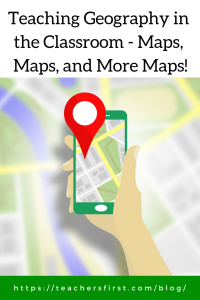 I remember geography as a subject taught with worksheets and maps pulled down in front of the chalkboard. A well-stocked classroom contained several maps to choose from – state, country, and the world. If you were fortunate, the teacher selected you to come to the front of the room to point to places on the map.
I remember geography as a subject taught with worksheets and maps pulled down in front of the chalkboard. A well-stocked classroom contained several maps to choose from – state, country, and the world. If you were fortunate, the teacher selected you to come to the front of the room to point to places on the map.
Although there is still a place for pull-down maps in the classroom, luckily, we have many other options to make learning about maps and geographic locations more interactive and meaningful. The digital resources also don’t limit map learning to just social studies lessons; they provide learners the opportunity to discover more about places in stories, hone in on specific areas of the world even down to the street view, and enable us to create maps based on our own needs.
TeachersFirst offers several different tools for finding and using maps in the classroom:
- The Geography Awareness and Exploration Resources Special Topics Page is a curated list of our editor’s favorites resources for classroom use in all grade levels. This Special Topics page includes a variety of reviewed resources for creating and exploring maps. One of my favorites from the collection is Overlap Maps (TeachersFirst review). Use this simple site to create maps comparing the size of countries, states, rivers, and more. As a very visual learner, I find these features invaluable in understanding and comparing different map features.
- Reading Treks uses Google Maps to create virtual field trips of resources to immerse readers in literature and text. Choose from titles like Tales of a Fourth Grade Nothing, Harriet Tubman and the Underground Railroad, or The Miraculous Journey of Edward Tulane to begin a Reading Trek. Each Trek correlates to Common Core, ISTE, Social Studies, and Arts Standards.
- Participate in the episodic adventures of GlobeTracker’s Mission (TeachersFirst review) created for grades 2-6. Throughout the school year, participants follow the journey of Geo and Meri on their global adventure as part of a secret mission for an unnamed government agency. Although this year’s trip is well underway, it’s not too late to join in and follow Geo and Meri through to the completion of this year’s adventure. Follow along on Twitter at @SFLGlobeTracker.
Here are some other excellent websites that offer unique ways to explore and learn about maps:
- Discover exciting places around the globe through maps, videos, and images with Google Map Treks (TeachersFirst review). Select from several world locations such as the Great Barrier Reef or Venice Italy to discover some of the world’s greatest treasures without leaving the classroom.
- Test your knowledge of trivia with Smarty Pins (TeachersFirst review). Try to answer random questions or choose from the various categories including Entertainment, History and Current Events, or March Madness to move a map pin to the correct place on the map.
- Most maps only show features as they look at the time of the map creation. What Was There (TeachersFirst review) provides the historical perspective on any location by integrating maps and photographs. Type in the name of a city, state, or country to view images giving context to the location’s history.
- For a fascinating look at the world through different categories, take a look at World Mapper (TeachersFirst review). Over 550 maps on the site tell the story of various topics by resizing maps. Use these maps to contrast and compare global connectivity, migration, and education.
There is no better way to learn about maps than by creating maps. There are many map creation tools available, take a look at TeachersFirst Edge Geo/Mapping tools for a large variety of map creation resources.
- Google My Maps (TeachersFirst review) lets you make and customize maps using icons, photos, videos, and drawing tools. One very nice feature is the ability to collaborate on maps similar to sharing and working with Google Documents. Use the Explore link to view examples and get ideas. This map of the Civil War is an excellent example of how to use this site in the classroom.
- History in Motion (TeachersFirst review) ties history together through maps, videos, documents, and images. Challenge your students to go beyond a simple retelling of events and use this site to animate and share the story through a visual presentation.
- Another wonderful storytelling tool is StoryMap (TeachersFirst review). StoryMap lets you tell your story set onto a map through the use of slides. Pull in media for your account from YouTube, Vimeo, SoundCloud, Twitter, and several other media sites. Be sure to check out the Tips and Tricks suggested for telling your story through StoryMap.
- ScribbleMaps (TeachersFirst review) includes tools for annotating maps using place markers, drawing tools, text, and more. Use the site’s shape tool to add buildings, people, vehicles, and more to your map.
Think of all of the many ways to include maps in your classroom. These resources make learning interactive, and enjoyable for you and your students. We all know that engaged, interested students leads to deeper learning.
How have you used maps in your classroom? Share your ideas in the comments below and help others learn new and exciting ways for using maps in any classroom.


My uncle used to be a teacher for elementary school and he was telling me that back then, there weren’t as many options to teach kids about Geography. I totally agree with you when you said that most maps now just show the modern features. Thanks for sharing this article, it helped me realize the importance of science assemblies in schools.